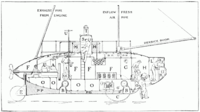Argonaut (submarine)


The Argonaut was a class of submarines built by engineer Simon Lake. When used without clarification generally refers to the second built and larger one launched in 1897 at Baltimore. She was 36-foot (11 m) long, cigar shaped and built of steel. She had a gas engine and propeller, dynamo, searchlight, and pumps for air and water. Her main attribute like that of the older sibling and predecessor Argonaut Junior (1894); was a wet diving chamber that allowed a diver to leave and re-enter the submarine. The "Argonaut No 1", and "Argonaut No 2" are used as the name of this vessel.
"Argonaut No 1" was built in 1897 and is 36 feet (11 m) in length. In September 1898 it made an open-ocean passage from Norfolk, Virginia, to Sandy Hook, New Jersey, becoming the first submarine to operate successfully in the open sea. [1] [2]
"Argonaut No 2" was a reconstruction of "Argonaut No 1" finishing in 1900 with a length of 60 feet (18 m) and significantly different profile.[3][4][5]
References
| Wikisource has original text related to this article: |
- ↑ "Hitler's Lost Sub: 400 years of subs". NOVA (PBS). November 2000. Retrieved 25 July 2013.
- ↑ Raanan, Gideon. "Submarines on Stamps: Simon Lake and his family of Argonauts and Protectors". Hadas Studio. Retrieved 25 July 2013.
- ↑ "Argonauts" (web). The Simon Lake Submarine Web Site. 2003. Archived from the original on 9 February 2008. Retrieved 2008-01-28.
- ↑ Corbin, Thomas W. Corbin (1913). The Romance of Submarine Engineering: Containing Interesting. Original from the New York Public Library: Seeley, Service & co., ltd. p. 109.
- ↑ Herbert C. Fyfe, Edward James Reed (1907). Submarine Warfare, Past and Present. Original from the University of California: E.G. Richards. p. 288.
- Poluhowich, John (1999). Argonaut: The Submarine Legacy of Simon Lake. Texas A&M University Press. p. 181. ISBN 0890968942.
See also
- Lake, Jeff. "Argonauts". The Simon Lake Submarine Web Site. Retrieved 13 April 2015.
- "Construction and Operation of the Submarine Boat Argonaut". Marine Engineering. II (2): 7–10. February 1898.